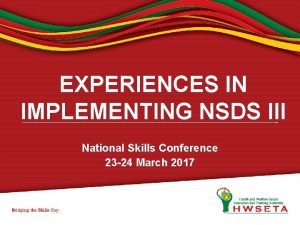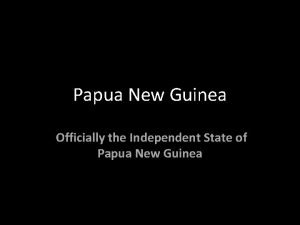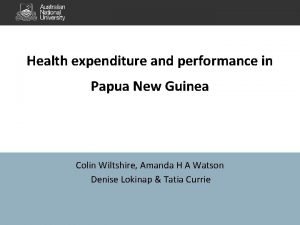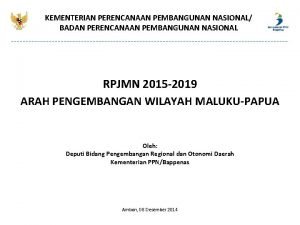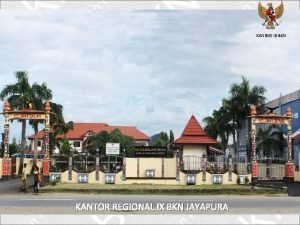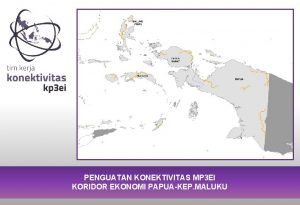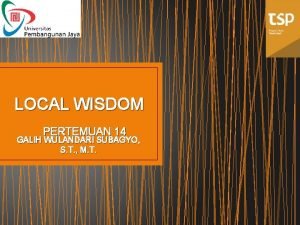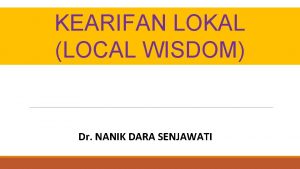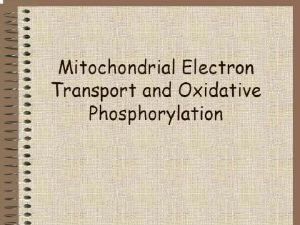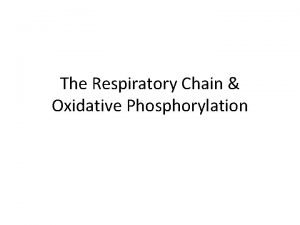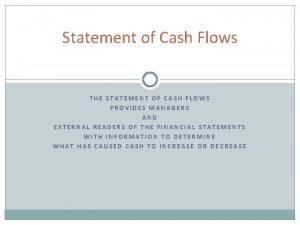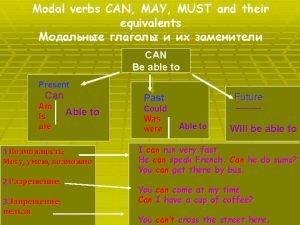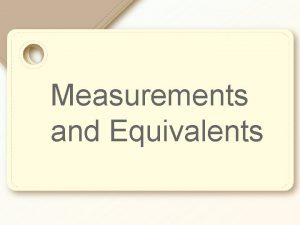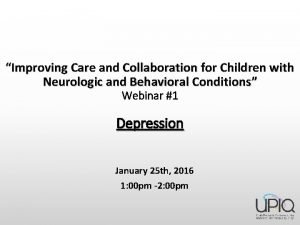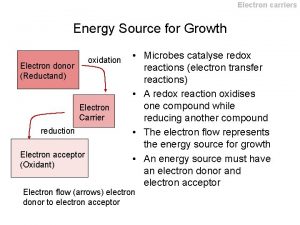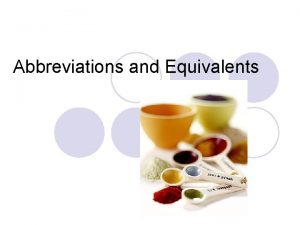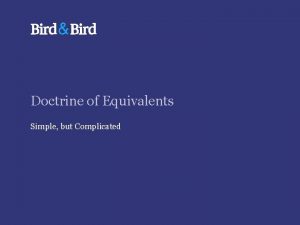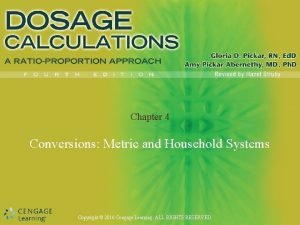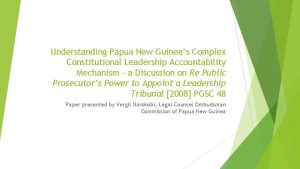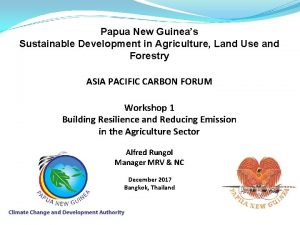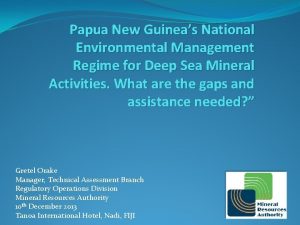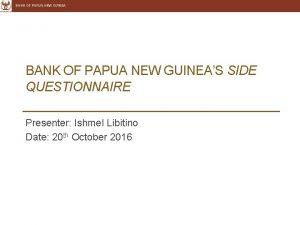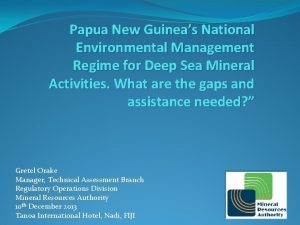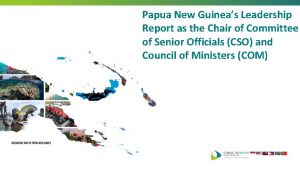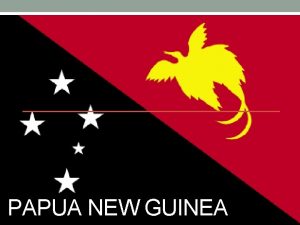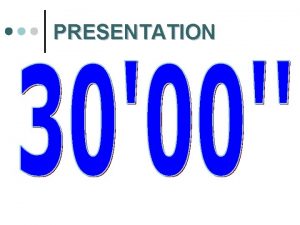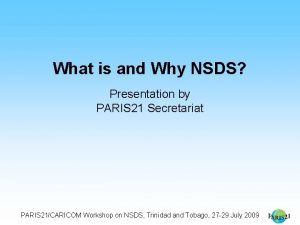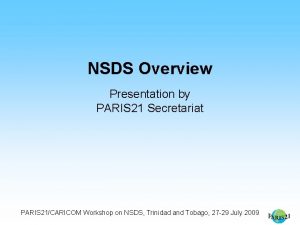Presentation of Papua New Guineas NSDS or equivalents




















- Slides: 20

Presentation of Papua New Guinea’s NSDS or equivalent’s development at the Workshop on NSDS in Small Island Developing States New York - USA 4 th – 5 th May 2006 by Dr. Albert Nita (NSDS Consultant) and Juliana Kubak, Advisor – Department of National Planning Martin Bonou : Advisor – Department of Petroleum & Energy

Presentation order § § § § § Background PNG’s development background 1. NSDS status 2. Aim of NSDS 3. Participation of stakeholders 4. Major achievements/best practices 5. Challenges 6. Outcomes/Way foreword 7. Acknowledgements

PNG’s Constitution Five National Goals & Directive Principles à Integral Human Development à Equality and Participation à National Sovereignty and Self Reliance à Natural Resources and the Environment à Papua New Guinean Ways

PNG’s Development Background (cont). . Strategies to Effect the 5 Goals since 1975 National Public Expenditure Planning – Infrastructure development – Growth through resource exploitation Integrated Rural Development – Less developed areas intervention – Multi-sectoral development approach Medium Term Development Strategies ─ MTDS (1997 -2002) Bridge into the 21 st Century ─ MTDS (2005 -2010)


1. NSDS Status and Milestones § 1990 PNG formally acknowledged the definition of Sustainable Development 1992 PNG Delegation to Rio and signed the Rio Declaration § 1992 Post UNCED Seminar (November) in Waigani § 1993 Waigani Seminar on Environment Development § 1994 Draft recommendations for NSDS Government endorses NSDS process & NSDS Task Force established § 1995 -2005 In PNG a Specific NSDS is absent. However, current government MTDS feature elements of what should amount to a NSDS.

2. Aims of NSDS or EQUIVALENT (Medium Term Development Strategy) § Papua New Guinea’s overarching development plan for economic and social development in harmony with environmental considerations. Approved by the NEC in November, 2004. • Integrates themes and considerations originally intended for the National Sustainable Development Strategy (NSDS), MDG and the National Poverty Reduction Strategy (NPRS).

2. Aims of NSDS or EQUIVALENT/ (MTDS) (cont) § To ensure ownership of and commitment to MTDS, extensive consultation was required between three levels of Government § Consultative Implementation and Monitoring Council (CIMC) Development Forums involving the Private sector, NGO’s and the Civil Society

2. Aims of NSDS or EQUIVALENT/ (MTDS) (cont) § MTDS Objective “Ultimately, the MTDS lays out the road map for Government to facilitate private sector driven economic growth, which is critical to improving the living standards and quality of life of ordinary Papua New Guineans”

3. Participation (P) of Stakeholders § Corporate developers exercise P as part of their corporate social responsibility § Legislation for stakeholder participation – – – Mining Act 1991 (Landowners) Environment Act 2000 Provincial & Local-Level Government Act 1995 § Partnership and strategic alliance is promoted

3. Participation (Cont. . ) § Limited Horizontal participation between key agencies. § Limited Vertical participation between levels of government exists.

4. MAJOR ACHIEVEMENTS § § § § Strengthening Good governance OLPLG 1995 (District Planning ) Environment Act 2000 MTDS (1997 -2002) MTDS (2000 -2004) MTDS (2005 -2010) Draft National Poverty Reduction Strategy Draft National Energy Policy is aligned with NSDS principles

5. MAIN CHALLENGES PNG has had opportunities but also faced challenges in: § Good Governance § Law and Order § Dysfunctional delivery system § Impediments to land utilization § HIV-AIDS § High population growth/Unemployment § Political instability/interference § Unplanned urbanisation

5. § § § § MAIN CHALLENGES (cont) Poverty reduction. Focus on sustainable rural development Biodiversity conservation Policy integration Adult literacy Empowerment of women and youth Financing of the MTDS priorities. Alignment of all sectoral policies with MTDS (20052010)

6. OUTCOMES / WAY FORWARD 1. COMPLETE a NSDS, and 2. INSTITUTIONALISE NSDS

6. OUTCOMES / WAY FORWARD. (Why do we need NSDS? ) cont. § Three pillars of Sustainable Developmentsocial, economic and environmental management. § Stakeholder participation/policy making and implementation § Enhance inter-agency collaboration § Effective monitoring and implementation/assessment § Maximum utilisation of scarce resources

6. OUTCOMES / WAY FORWARD. (Why do we need NSDS? ) cont. § § § § Collaborate with all three (3) tiers of governments Institutional strengthening (internal & systems) Good governance – accountability & transparency Globalise PNG’s issues Develop national targets/indicators to achieve the 5 Goals, MDG’s, JPOI and nationally agreed development goals. Mobilization of resources Complements existing development efforts in an integrated manner

6. OUTCOMES / WAY FORWARD. cont. . (PROCESS OF FORMULATION OF PNG’S NSDS)

7. Acknowledgement § Special Thanks to: – UNDESA for Supporting the PNG Delegation - H. E. Amb. Robert Aisi of PNG Mission to UN & Chair of the PIF, PIF Ambassadors & Missions & PIF Working Group – Mr. Sakias Tameo of PNG Mission to UN for his tireless efforts – Ambassadors & Missions of Malaysia, Indonesia and India

THE END
 Nsds iii
Nsds iii Difference between nsds and hrds
Difference between nsds and hrds Independent state of papua new guinea
Independent state of papua new guinea Papua new guinea
Papua new guinea Maluku papua
Maluku papua Cek berkas kp bkn jayapura
Cek berkas kp bkn jayapura Perkim
Perkim Aro neweak lako
Aro neweak lako Te aro neweak lako
Te aro neweak lako Reducing equivalents
Reducing equivalents Reducing equivalents
Reducing equivalents Could modal feli
Could modal feli Cash equivalents examples
Cash equivalents examples Equivalent of may
Equivalent of may Measurements equivalents and adjustments
Measurements equivalents and adjustments Vilazadone
Vilazadone Reducing equivalents
Reducing equivalents Abbreviation for tablespoon
Abbreviation for tablespoon Doctrine of equivalents test
Doctrine of equivalents test Metric and household measurements
Metric and household measurements Measurements abbreviations and equivalents
Measurements abbreviations and equivalents
